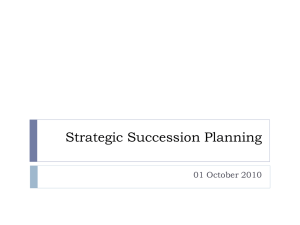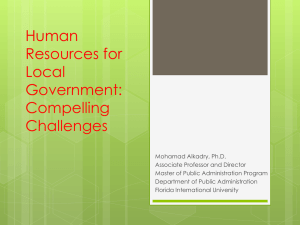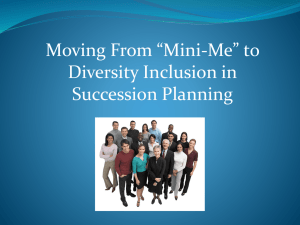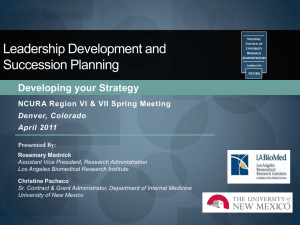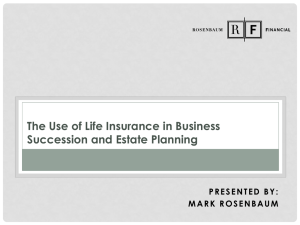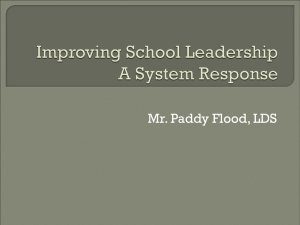High Impact Succession Management
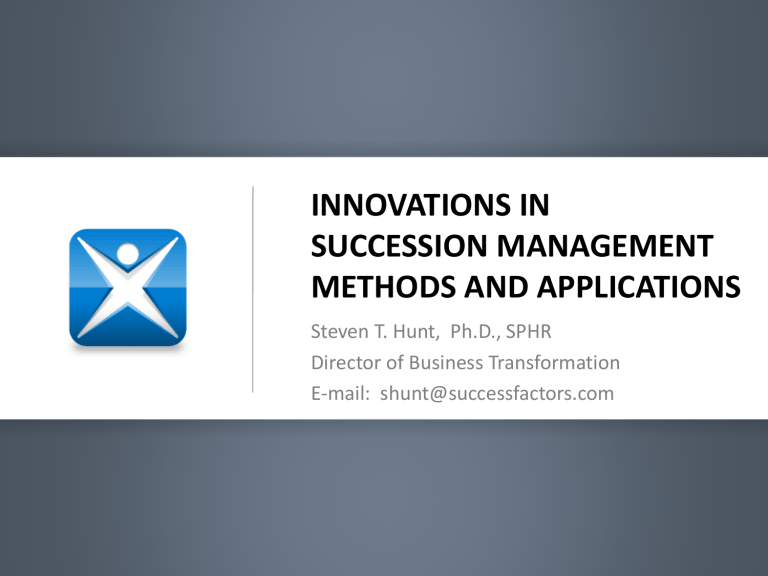
INNOVATIONS IN
SUCCESSION MANAGEMENT
METHODS AND APPLICATIONS
Steven T. Hunt, Ph.D., SPHR
Director of Business Transformation
E-mail: shunt@successfactors.com
Agenda
I.
What is high impact succession management?
II. Major succession management questions
1) What are the business goals?
2) Who to include in the process?
3) How to evaluate talent?
4) How to develop talent?
5) How to deploy the process?
III. Conclusion
2
High Impact Succession Management
Replacement Planning
– Who should replace this person if they leave?
– Depends on creating lists of available candidates
High Impact Succession Management
• How can we maintain a steady supply of high performing talent in pivotal roles across the organization?
• Depends on aligning
– Career Development to help employees achieve their full potential
– Performance Management to evaluate and improve the effectiveness of employees in their current role
– Recruiting to fill positions with the best available talent
– Workforce planning to anticipate and prepare for future talent needs.
– Compensation to incent people who develop high potential talent and to encourage high potential talent to remain with the company
Effective succession management integrates multiple talent management processes
Objectives
Appraisal
(April/May)
Employee
Profile
(Jan.)
Objective
Setting
(April/May)
Performance
Appraisal
(Feb./Mar.)
Strategic
Staffing
On-going
Succession Planning
Career
Develop.
Assessment
(July/Aug.)
360-degree
Assessment for HPPs
(Jan.)
Succession
Planning
(Dec./Jan.)
Career
Development
Planning
(Nov./Dec.)
HPP/
9-Block
(Sept.-Oct.)
From Jim Irvine
Nissan, Inc.
4
Technology makes this integration possible
• Effectively collecting and tracking talent information
• Sharing data across processes
• Providing access to tools for identifying, evaluating & developing talent
5
Question 1. What are the goals of succession management and how can you measure them?
Question 1. What are the goals of succession management and how can you measure them?
Succession Impact
Identify candidates for key roles
Rapidly fill positions
More accurate staffing decisions
Accelerate development
Increased employee engagement & retention
Shared expectations about talent & performance
Increase diversity in key positions
Retain critical organizational expertise
Succession Metrics
% of key positions filled
Time to fill for key roles
Turnover rate of high potential employees
% of positions filled with internal promotions
% of employees with career development plans
# of “ready now” candidates identified for key roles
% of employees with certain demographics in key roles
Employee engagement scores
Business Outcomes
Retention of high performers
Quality of leadership
Market share
Profit and Loss
New product innovations
Decreased litigation
Consistent production output and quality
Customer satisfaction
…other things relevant to non-
HR leaders
1. What are the goals of succession management and how can you measure them?
• What is the benefit of effective succession management from the perspective of:
– Leaders
– Managers
– Employees
– Human Resources
• What metrics will show that your succession management process is working:
– In six months?
– In one year?
– In three years?
Question 2. What positions and people will be included in the succession management Process?
9
Moving from person to process based
Succession Management
Person Based Succession
Asks: “who do I need to replace and who do I know that can replace them?
Emphasizes filling currently open positions
Decisions largely based on “who you know”
Pressures leaders to change jobs to fit the needs of the available candidates
Rewards leaders who horde top talent so they have it when they need it
Moving from person to process based
Succession Management
Person Based Succession
Asks: “who do I need to replace and who do I know that can replace them?
Process Based Succession
Asks: “what are the pivotal jobs in the company and where can we find the talent to perform these jobs”
Emphasizes filling currently open positions
Decisions largely based on “who you know”
Emphasizes planning and maintaining a steady supply of talent for ongoing workforce demands
Decisions based on clearly defined criteria for assessing potential
Pressures leaders to change jobs to fit the needs of the available candidates
Enables leaders to develop candidates to meet the requirements of the job
Rewards leaders who horde top talent so they have it when they need it
Encourages leaders to share talent with confidence that equal or better talent will be shared with them
2. What positions and people will be included in Succession Management?
• What are the key positions in the organization?
– Pivotal roles: where small differences in performance have large impacts on profitability
– Critical roles: that are crucial to keeping the business running
– Developmental roles: that are instrumental to preparing employees for pivotal and critical roles
• What people are consider as potential candidates for these positions?
– Based on current job or role
– Based on specific qualifications
– Based on manager and/or self-nomination
– Why not include everyone who works for you?
Question 3. How will candidates be identified, qualified, and evaluated for roles?
13
What makes someone a good candidate?
Aspirations, mobility, constraints
Career Goals
(What employees
WANT TO DO)
Learning Agility
(What employees CAN
DO)
Cognitive, Social,
& Change capablities
Technical
Qualifications (What employees HAVE DONE)
Skills and experiences
Common types of evaluation criteria
Qualification Criteria
– Requirements: time in current role, citizenship requirements, current position, etc.
– Nomination process: manager recommendation, self identification, etc.
“Hard” Criteria
– Career Goals & Constraints
• Job interests, geographic mobility
– Skills & Experiences
“Soft” Criteria
– Job Relevant Competencies
– Learning Capabilities
• Cognitive Ability, Social/Relationship Skills, Dealing with Change
Commitment Criteria
– Turnover risk
– Support for company mission and values
Building an employee scorecard
16
Comparing succession candidates
Question 4. How will candidates be developed?
18
Question 4. How will candidates be developed?
Stretch assignments
Doing things people have not done before
5
4
3
2
1
Where people realize their potential
1 2 3 4 5
Critical assignments
Doing things that are important to business success
4. How will candidates be developed?
Most
Effective t c p a
I m a) Will “hi pos” be formally notified?
b) How will managers be incented to develop candidates?
Action learning/stretch work assignments
Developmental job assignments
High potential leadership programs
(leadership academies)
Active mentoring relationships
360 feedback
& coaching
Independent training
Least
Effective
Informal feedback
Leadership support
Question 5. How can you ensure adoption of
Succession Methods?
21
Takes about 3 years to turn succession from an “event” to a way of doing business
Impact
Transformation
Talent mgmt practices aligned to specific business needs
Strategic Change: Platform for strategic change and optimal utilization of talent
Talent management processes evaluated & predicted based on well-defined data analytics
Operational Insight
:
Datadriven insights for understanding, monitoring , and improving talent
Integration/Consolidation
Well-defined and widely adopted methods and tools
Comprehensive: Methods effectively supporting major talent management needs
Automation
Technology enabled talent management processes
Manual
Basic processes defined for managing talent
Efficiency: Efficient & consistent methods; able to monitor usage
Standardization:
Defined methods, often inefficient & inconsistently used
Undefined
Talent decisions based on local knowledge & practices
Confusion & underutilization:
Uncontrolled; inefficient; high risk treatment of employees
Organization Maturity
22
5. How can you ensure adoption and use of
Succession Methods?
Common Reasons for resisting Succession Management
• Senior Leaders: Must use a consistent and transparent process to promote talent. Cannot base decisions solely on “intuition”. Must defend talent choices.
– What incentives are in place to ensure senior leadership embraces, supports and actively participates in the process?
• Managers: Must nominate and risk losing their best people to another part of the business. In return, they will get people not fully ready for the open position who may be unfamiliar to them.
– How are managers rewarded for developing talent for other parts of the company?
• Employees: Are evaluated and labeled. Pressure on high po’s to achieve superior results. Low po’s feel undervalued with no career future.
– How are people treated if they do not qualify or do not want to be high po’s? What assurances do employees have that they might become a high po’s in the future?
• Human Resources: Must comply with processes from “corporate”. May resist methods that they feel are not right for their group our department.
– What methods do local HR professionals have that will allow them to influence or modify the process to ensure it aligns with local cultural and business needs?
23
Final thoughts on getting started
• Start small and build over time, but have a roadmap for scaling
– Create methods that allow you to measure who is or is not following the process
• Leverage and integrate existing talent management processes;
– Collect data once and use it multiple times
• Take action based on evaluations;
– Succession planning without development is just “taking inventory”
• Give employees and managers an incentive to actively participate in the process
Thank you for your time and attention!
For more information: a) E-mail me at “shunt@successfactors.com” b) SuccessFactors white paper “The Five Key Questions for Creating High Impact
Succession Management Programs” (www.successfactors.com) c) Interviews on Business Execution Radio: http://www.successfactors.com/podcast
